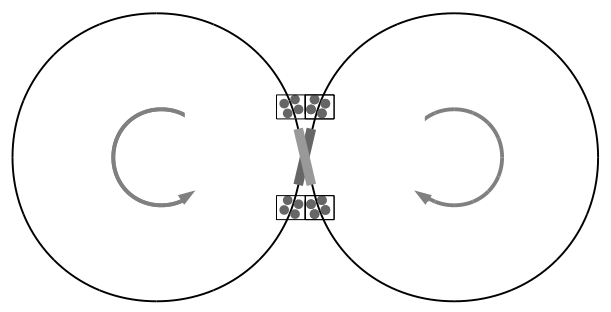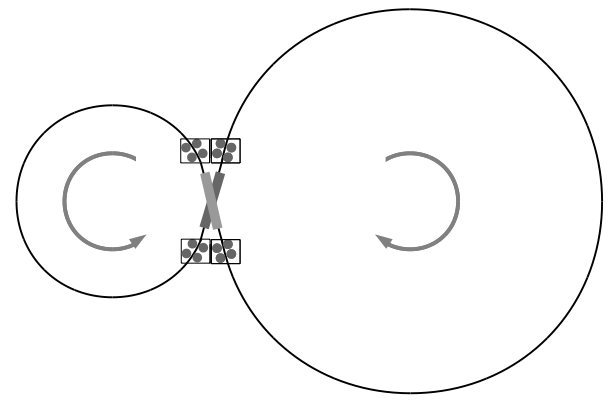Torque Radiator for SSPS
Server sky will produce data worth far more per space megawatt-hour than grid electricity, but after a terawatt of global data service is generating $40T per year of profits(1), those profits, plus the launch and deployment infrastructure developed for server sky, can pay for additional revenue from space solar power delivered to Earth as "dumb" energy. 50 Terawatts of electricity at $20/MWh might be only $10T per year, but cheap clean grid electricity can power more data-enabled terrestrial applications, increasing data demand and supporting further server sky system growth. Sell the data, and give away the power to use more of it below cost.
So, it makes sense to think about "gossamer technology" techniques for generating "dumb" space power. Transmitting space power as microwaves to Earth is very very difficult; due to diffraction limits, the transmitters and receivers must be enormous, square kilometer scale as opposed to the square-decimeter scales of thinsats. Because of the "sparse array curse", the power transmitters must operate as large physically continuous systems, which subjects them to tidal forces that cannot be corrected with light pressure. We must rely on physical strength of materials, though we can still be clever about how to use those materials in a gossamer way.
The radiator problem
Some proposals for the power plants driving the microwave generators are photovoltaic surfaces, others propose heat engines. The problem with heat engines is that they must radiate the waste heat with black body radiation, and radiating that heat at a low temperature requires a very large surface. Most proposals assume radiating fluid (liquid or gas) coolant in sealed pipes and channels. There are many problems with this:
- The channels can freeze during eclipses at the equinoxes, as the orbit passes into the shadow behind the Earth, up to 70 minutes of darkness and cold. Not complete 2.7K deep space cold; the Earth radiates infrared heat at 250K, and attenuated by distance, that will keep a flat radiator facing earth at about 100K. Still, that is certainly cold enough to freeze any working fluid with a decent specific heat that is liquid or gas at heat-turbine working temperatures. A lightweight radiator will have very small thermal mass as well, and will plummet towards 100K quickly.
- Sealing plumbing against micrometeoroid damage will also be difficult.
- Fluid radiators suffer from scaling issues; transmitting heat twice as far across a radiator requires twice as much fluid in transit. The amount of fluid scales as the square of the radiator surface. The amount of power wasted pumping it around goes up, too; it has farther to go, and more wall viscosity to push past.
The torque problem
SSPS systems suffer from another big problem - they must keep their solar collection systems (PV or mirrors) pointed at the Sun, following it as it seems to rotate around an axis perpendicular to the orbit direction and the tidal vector towards the Earth. The panels will be tilted around that perpendicular axis, which means they will generate torques along that axis, too. Holding them steady (as opposed to oscillating back and forth perhaps 20 degrees over a 24 hour period) requires added torque.
Stringing the system vertically, and adding a "kite tail" mass towards earth, seems like a solution; unfortunately, this system will be end-on towards the Sun near noon and midnight, and unless the collectors stick out in different directions, they will shade each other. However the system is arranged, the collectors must always be spread out relative to the Sun by their area, and change configuration to accomodate that, generating torque forces that must be countered with other torque forces.
For many satellites, the solution is "momentum wheels" - heavy flywheels on bearings inside boxes. Flywheels have maximum rim speeds, proportional to the square root of the material strength divided by the density, on the order of 1000 meters per second for strong materials like Kevlar. The angular momentum (torque multiplied by time) is proportional to the rim speed times the rim mass times the radius. Storing a lot of angular momentum in a limited size satellite box (restricting wheel radius) requires a lot of mass, and the high RPMs make bearings fail. The Kepler space observatory was crippled when its momentum wheels failed.
Torque radiators
Let's abandon two crippling assumptions:
- 1 The torque wheels must stay in the box. WRONG.
We have trillions of cubic kilometers of empty vacuum to deploy into.
- 2 The radiator must distribute the heat in fluid. WRONG.
- We can move heat in solids, which do not evaporate in vacuum, and do not leak when punctured by a micrometorite.
The specific heat of water is 4.2 J/g-°C, and the phase change properties can move a lot of energy. However, the specific heat of Kevlar is 1.4 J/g-°C, and it "remains Kevlar" over a much wider range of temperatures. More importantly, Kevlar can move a lot faster than water can, with zero friction in vacuum. A "nozzle" emitting a wide gossamer sheet of hot Kevlar into space can move a LOT of heat. If the Kevlar surface is designed for high infrared emissivity (an electrical resistance of "spacecloth") it can radiate the heat very fast. A big loop of Kevlar can be shot out into space, where it radiates and cools, then is pulled back into the working core by adaptive rollers. The speed of sound in Kevlar is around 7000 meters per second, so tension waves propagate far faster than the 1000 meter per second band can move - with good modelling and a series of fast actuators, a stream of Kevlar can be positioned and oriented to feed back into the rollers for another cooling pass. After all, it only moves a millimeter per microsecond, the time it takes for a measurement laser beam to move 150 meters out and back.
(1) Google earns $10/MWhr for commodity data services; highly customized information services provided from and for 3 billion limitlessly-enabled creatives in the developing world should be able to outperform Google's 60,000 employees (generating profits approaching $1M per employee).


